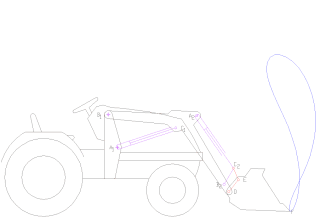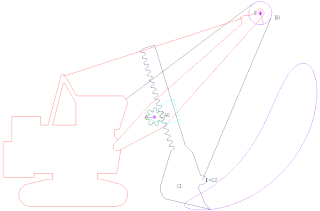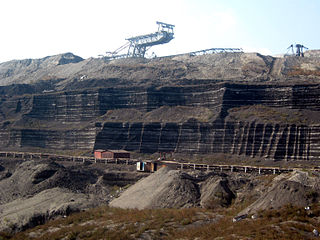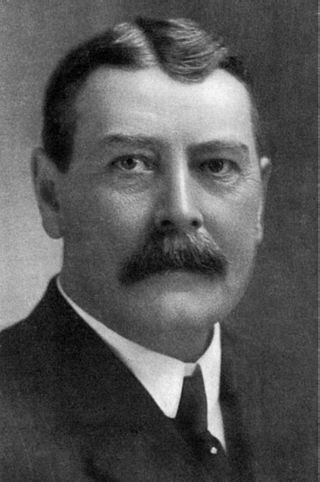
Excavators are heavy construction equipment consisting of a boom, dipper, bucket and cab on a rotating platform known as the "house". The house sits atop an undercarriage with tracks or wheels. They are a natural progression from the steam shovels and often mistakenly called power shovels. All movement and functions of a hydraulic excavator are accomplished through the use of hydraulic fluid, with hydraulic cylinders and hydraulic motors. Due to the linear actuation of hydraulic cylinders, their mode of operation is fundamentally different from cable-operated excavators which use winches and steel ropes to accomplish the movements.

A loader is a heavy equipment machine used in construction to move or load materials such as soil, rock, sand, demolition debris, etc. into or onto another type of machinery.

Heavy equipment or heavy machinery or Earthmover refers to heavy-duty vehicles specially designed to execute construction tasks, most frequently involving earthwork operations or other large construction tasks. Heavy equipment usually comprises five equipment systems: the implement, traction, structure, power train, and control/information.

A dragline excavator is a piece of heavy equipment used in civil engineering and surface mining.

A reclaimer is a large machine used in bulk material handling applications. A reclaimer's function is to recover bulk material such as ores and cereals from a stockpile. A stacker is used to stack the material.

Surface mining, including strip mining, open-pit mining and mountaintop removal mining, is a broad category of mining in which soil and rock overlying the mineral deposit are removed, in contrast to underground mining, in which the overlying rock is left in place, and the mineral is removed through shafts or tunnels.

Bagger 288, built by the German company Krupp for the energy and mining firm Rheinbraun, is a bucket-wheel excavator or mobile strip mining machine.

A bucket-wheel excavator (BWE) is a large heavy equipment machine used in surface mining.

Big Muskie was a coal mining Bucyrus-Erie dragline excavator owned by the Central Ohio Coal Company, weighing 13,500 short tons (12,200 t) and standing nearly 22 stories tall. It operated in the U.S. state of Ohio from 1969 to 1991.

A landship is a large vehicle that travels exclusively on land. Its name is meant to distinguish it from vehicles that travel through other mediums such as conventional ships, airships, and spaceships.

A coal preparation plant is a facility that washes coal of soil and rock, crushes it into graded sized chunks (sorting), stockpiles grades preparing it for transport to market, and more often than not, also loads coal into rail cars, barges, or ships.

A power shovel is a bucket-equipped machine, usually electrically powered, used for digging and loading earth or fragmented rock and for mineral extraction. Power shovels are a type of rope/cable excavator, where the digging arm is controlled and powered by winches and steel ropes, rather than hydraulics like in the more common hydraulic excavators. Basic parts of a power shovel include the track system, cabin, cables, rack, stick, boom foot-pin, saddle block, boom, boom point sheaves and bucket. The size of bucket varies from 0.73 to 53 cubic meters.
TAKRAF Group (“TAKRAF”), is a global German industrial company. Through its brands, TAKRAF and DELKOR, the Group provides equipment, systems and services to the mining and associated industries.

F60 is the series designation of five overburden conveyor bridges used in brown coal (lignite) opencast mining in the Lusatian coalfields in Germany. They were built by the former Volkseigener Betrieb TAKRAF in Lauchhammer and are the largest movable technical industrial machines in the world. As overburden conveyor bridges, they transport the overburden which lies over the coal seam. The cutting height is 60 m (200 ft), hence the name F60. In total, the F60 is up to 80 m (260 ft) high and 240 m (790 ft) wide; with a length of 502 m (1,647 ft), it is described as the lying Eiffel tower, making these behemoths not only the longest vehicle ever made—beating Seawise Giant, the longest ship—but the largest vehicle by physical dimensions ever made by mankind. In operating condition, it weighs 13,600 metric tons making the F60 also one of the heaviest land vehicles ever made, beaten only by Bagger 293, which is a giant bucket-wheel excavator. Nevertheless, despite its immense size, it is operated by only a crew of 14.

The Miraš open-cast coal mines are lignite coal mines in Kosovo operated by the Kosovo Energy Corporation (KEK).

P&H Mining Equipment designs, builds and supports a line of drilling and material handling machinery marketed under the "P&H" trademark and applied to minerals and energy surface mining operations worldwide. The firm is an operating subsidiary of Joy Global Inc. In 2017 Joy Global Inc. was acquired by Komatsu Limited of Tokyo, Japan and is now known as Komatsu Mining Corporation and operate as a subsidiary of Komatsu.

Joy Global Inc. was a company that manufactured and serviced heavy equipment used in the extraction and haulage of coal and minerals in both underground and surface mining. The company had manufacturing facilities in Alabama, Pennsylvania, Texas, Wisconsin, Australia, Canada, China, France, South Africa and the United Kingdom. In 2017, Joy Global was acquired by Komatsu Limited and was renamed Komatsu Mining Corp.

TAKRAF India Private Limited is a wholly owned subsidiary of TAKRAF GmbH. As with its parent company, TAKRAF India provides equipment, systems and services to the mining and associated industries through the TAKRAF and DELKOR brands.

A bucket chain excavator (BCE) is a piece of heavy equipment used in surface mining and dredging. BCEs use buckets on a revolving chain to remove large quantities of material. They are similar to bucket-wheel excavators and trenchers. Bucket chain excavators remove material from below their plane of movement, which is useful if the pit floor is unstable or underwater.
A conveyor bridge is a piece of mining equipment used in strip mining for the removal of overburden and for dumping it on the inner spoil bank of the open-cut mine. It is used together with multibucket excavators, frequently bucket chain excavators, that remove the overburden which is moved to the bridge by connecting conveyors. Conveyor bridges are used in working horizontally layered deposits with soft overburden rock in areas where mean annual temperatures are above freezing. They are frequently used in lignite mining.

















